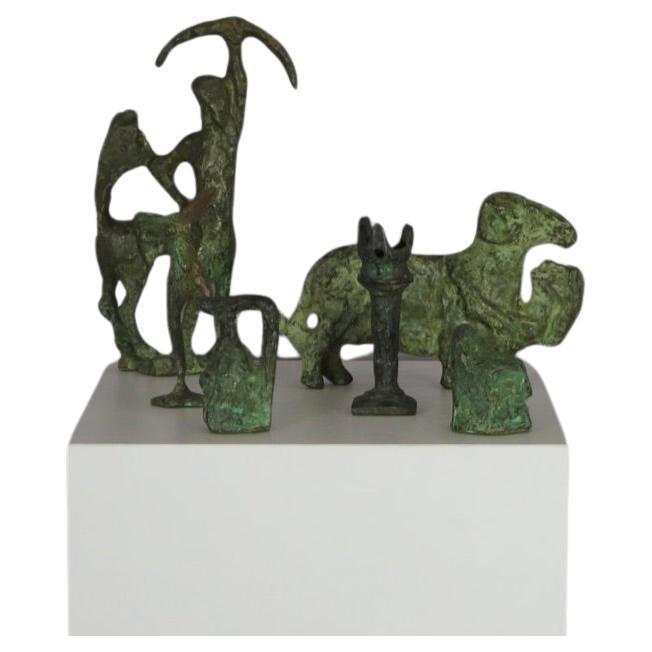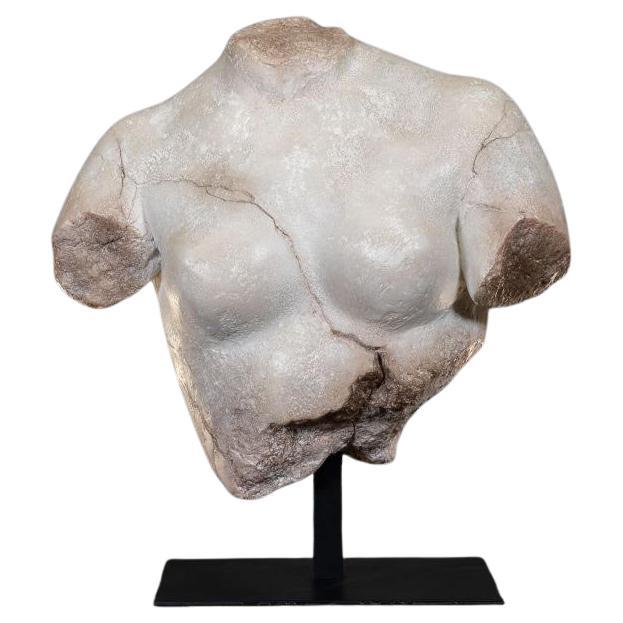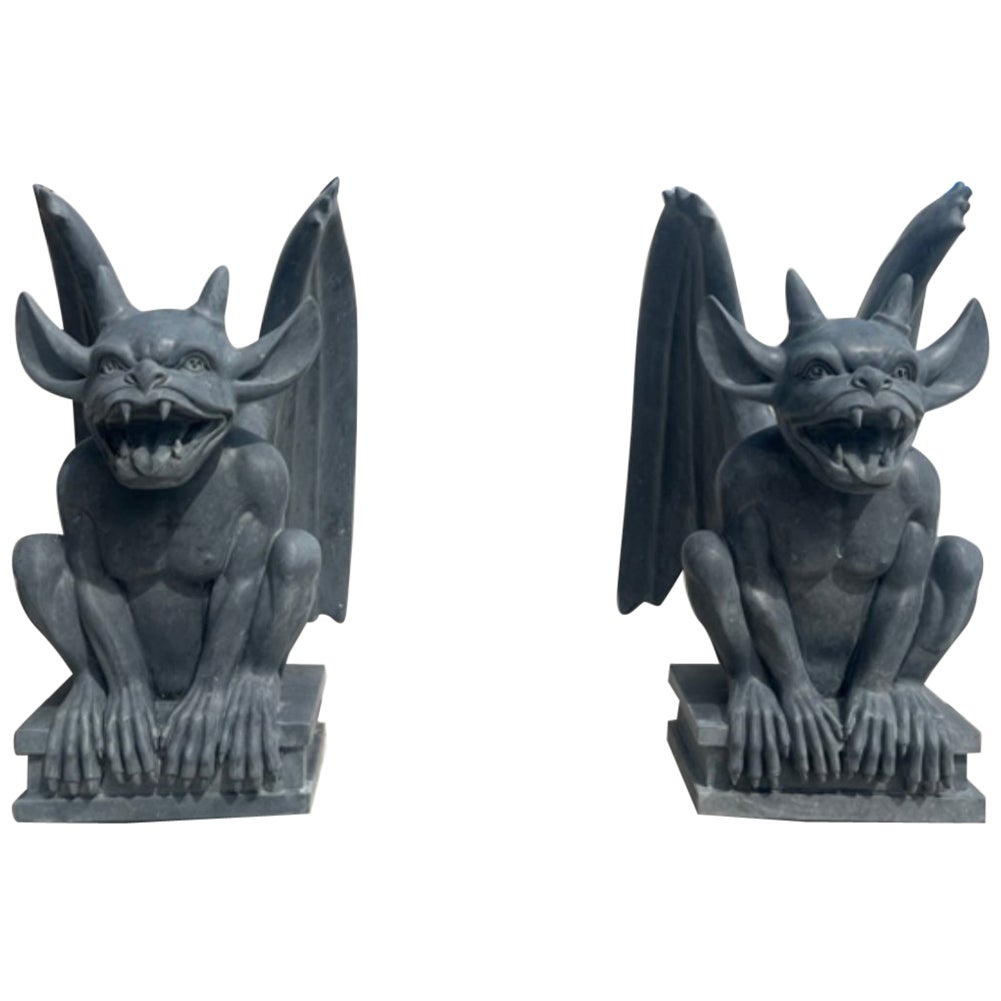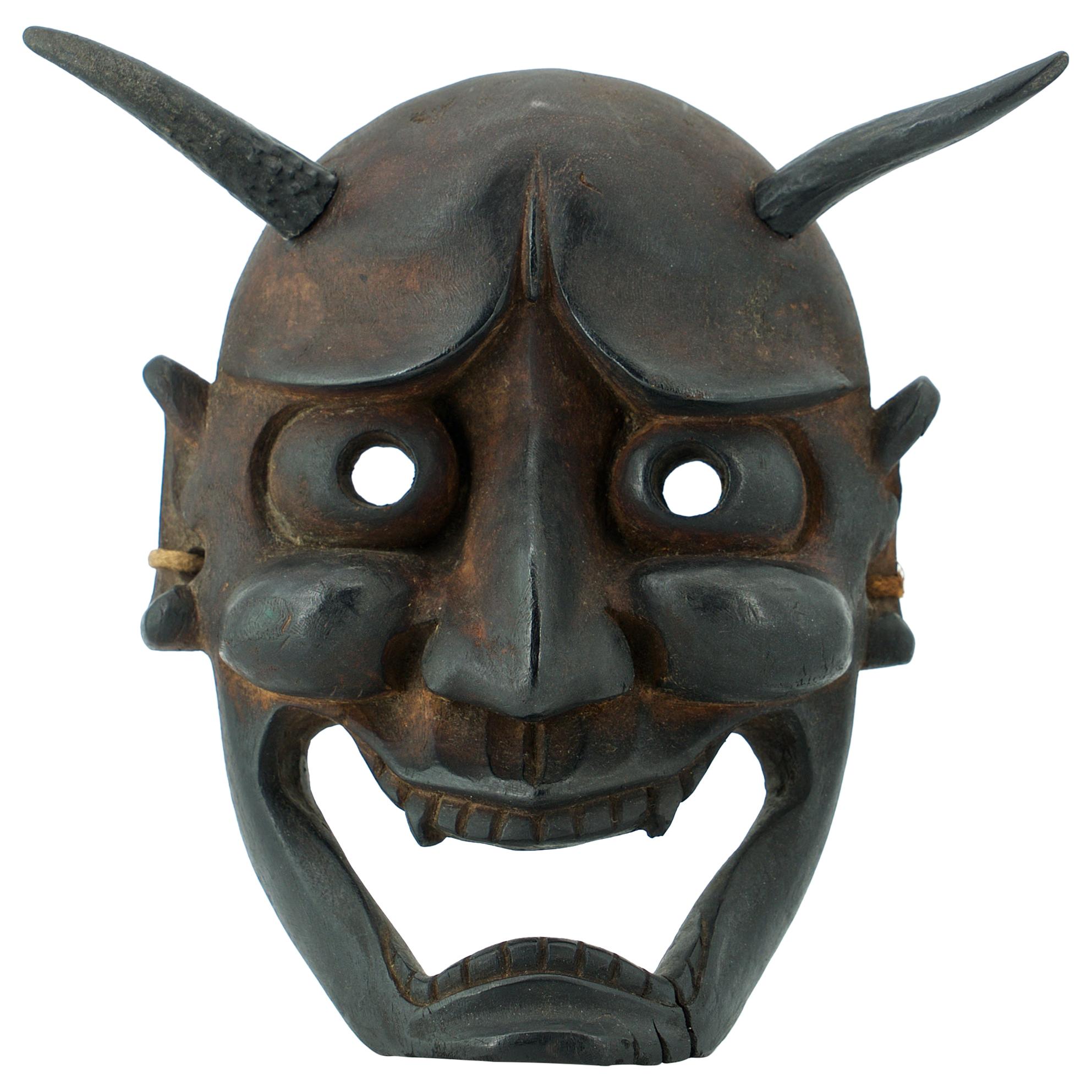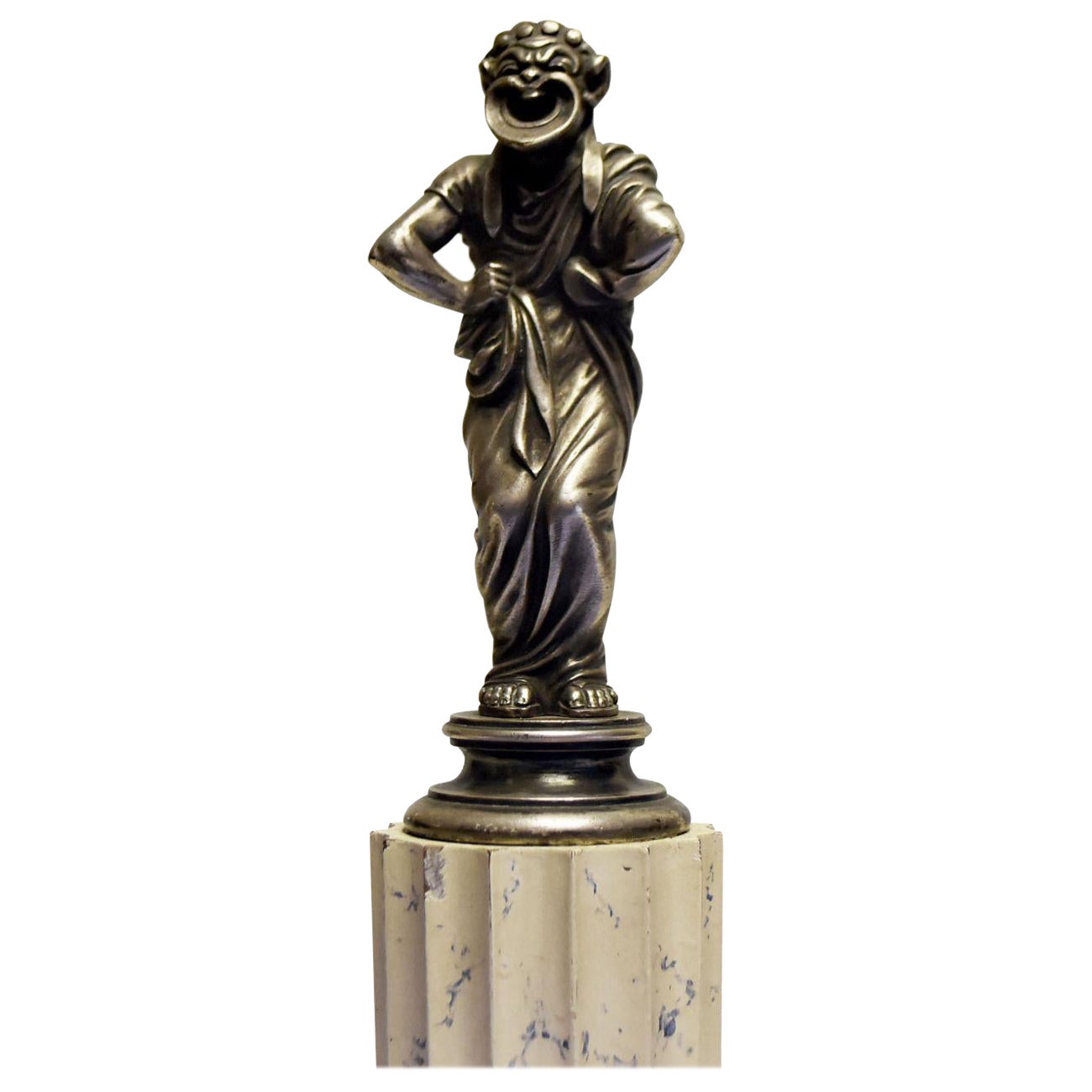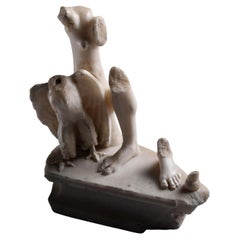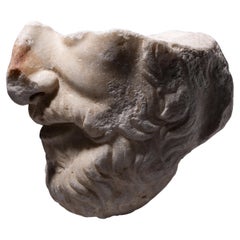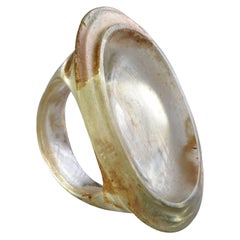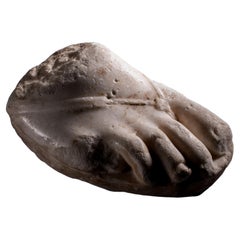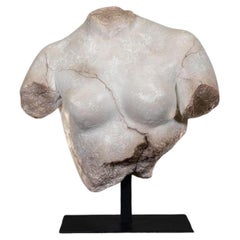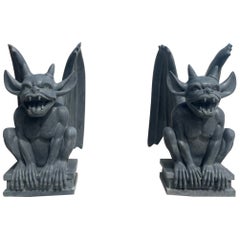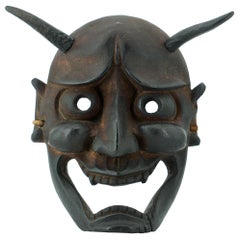Items Similar to Hellenistic Grotesque Theatre Mask of Maccus
Video Loading
Want more images or videos?
Request additional images or videos from the seller
1 of 10
Hellenistic Grotesque Theatre Mask of Maccus
About the Item
Grotesque theatrical mask of Maccus
Late Hellenistic or Early Imperial period, circa 1st century B.C. – 1st century A.D., likely from Southern Italy.
Terracotta with remains of pink and white pigment
Measure: Height: 20 cm.
With old label reading '‘n° 45''
This highly expressive terracotta mask is incredibly well-preserved, perhaps the best of all known masks of the Maccus type. It depicts a man with grotesque, comically deformed features. The face is broad with protruding ears, the hook-shaped nose is large and crooked, and the grimacing, gaping mouth reveals the figure’s bottom teeth. The eyebrows are frowning, accentuating the wrinkled forehead, and the man has a hunch on top of his bald skull. Holes have been pierced through the forehead and on each side of the mask, by which it would once have been attached, to a plinth or wall, as a hanging decorative object.
Under the influence of Greek settlers, a vibrant theatre tradition was established in and around the Southern Italian peninsula from at least the fifth century B.C. The comic genres focusing on social satire and mockery were particularly popular amongst both Greeks and native Italic people. In the Greek colonies, a new genre of farce was developed in the 4th century B.C. - the Phlyax plays, a form of mythological burlesque blending figures from the Greek pantheon with tropes borrowed from Athenian New Comedy. One of the most popular characters was Maccus, a bald, hunchbacked, crooked-nosed, and large-eared peasant, driven and derided by greed, whose physical description is reminiscent of the present mask. It was this genre of comedy that, through contact between the Southern Italian Greeks and their neighbours to the North, would later become beloved by the Romans.
It is important to note that stage performers did not wear masks in terracotta. Rather, they wore masks fashioned out of perishable materials such as wood, linen, or leather. Terracotta masks such as this one were modelled after these and deposed in sanctuaries or used as garden decoration. The use of masks as decorative ornaments testifies to the popularity of the dramatic arts in Rome and a strong aesthetic appreciation for theatre costumes. Indeed, props such as masks strongly enhanced the audience’s visual and aesthetic experience. As such, they were undoubtedly part of why farces were so loved by the public and thus became iconic elements of Roman public and cultural life. Depictions of theatrical scenes, actors, and masks can be found across the Roman arts, from sculptures to mosaics, frescoes, and reliefs, decorating both private and public buildings throughout the Empire.
Provenance:
- From the collection of Louis-Gabriel Bellon (1819-1899), Saint-Nicolas-lez- Arras and Rouen, thence by descent.
- Dimensions:Height: 7.88 in (20 cm)Diameter: 7.49 in (19 cm)
- Style:Classical Roman (Of the Period)
- Materials and Techniques:
- Place of Origin:
- Period:
- Date of Manufacture:circa 1st Century B.C.-1st Century A.D.
- Condition:
- Seller Location:London, GB
- Reference Number:Seller: 429731stDibs: LU1052232061902
About the Seller
5.0
Recognized Seller
These prestigious sellers are industry leaders and represent the highest echelon for item quality and design.
Established in 2008
1stDibs seller since 2014
100 sales on 1stDibs
Typical response time: 2 hours
Associations
LAPADA - The Association of Arts & Antiques DealersInternational Confederation of Art and Antique Dealers' AssociationsThe British Antique Dealers' Association
- ShippingRetrieving quote...Shipping from: London, United Kingdom
- Return Policy
Authenticity Guarantee
In the unlikely event there’s an issue with an item’s authenticity, contact us within 1 year for a full refund. DetailsMoney-Back Guarantee
If your item is not as described, is damaged in transit, or does not arrive, contact us within 7 days for a full refund. Details24-Hour Cancellation
You have a 24-hour grace period in which to reconsider your purchase, with no questions asked.Vetted Professional Sellers
Our world-class sellers must adhere to strict standards for service and quality, maintaining the integrity of our listings.Price-Match Guarantee
If you find that a seller listed the same item for a lower price elsewhere, we’ll match it.Trusted Global Delivery
Our best-in-class carrier network provides specialized shipping options worldwide, including custom delivery.More From This Seller
View AllRoman Marble Statuette of Jupiter
Located in London, GB
Roman Marble Fragment of jupiter
Circa 2nd-3rd Century A.D.
Measure: Height: 19.7 cm
This beautiful Roman fragmentary statuette depicts Jupiter, the king of the gods, here recognisable from his two chief attributes, the eagle with outstretched wings - according the Pseudo-Hyginus, singled out by Jupiter because ''it alone, men say, strives to fly straight into the rays of the rising sun'' - and the base of the scepter, which remains at the side of the left foot, an aspect likely borrowed from the statue of Zeus at Olympia, once one of the Seven Wonders of the World. Though much of the original piece has been lost, the subtle anatomical detail in the feet mark this out as a piece of exceptional quality, and the work of an artist of particular talent and patience - as Johann Winckelmann once said of the famous Belvedere Torso, ''if you contemplate this with a quiet eye [...] the god will at once become visible in this stone.''
This fragment once caught the eye of Henry Howard, 4th Earl of Carlisle (1694-1758), a Knight of the Garter and among the most prolific collectors of his day. The piece, acquired during his travels to Rome, was proudly displayed on an alcove of the Western Staircase of Castle Howard...
Category
Antique 15th Century and Earlier Italian Classical Roman Figurative Scul...
Materials
Marble
Roman Marble Head of Sophocles
Located in London, GB
Roman Marble Head of Sophocles
Circa 1st-2nd Century
Marble
This fine Roman marble head preserves the proper left side of the face of a middle-aged man, with broad nose, soft lips, and bearded chin. The short beard and sideburns have been finely carved with a flat chisel, to render the soft, wavy strands of hair. The cheekbone, undereye, and nasolabial folds have been delicately modelled in the marble by a skilled hand. In a letter from 1975, the former director of Ny Carlsberg Glyptotek, Copenhagen, suggested that the head could depict the Ancient Greek tragedian Sophocles.
Few figures in the Classical world stand aside Sophocles (c. 496-406 BC), inarguably the best known of the Athenian tragedians, in terms of the impact his works have had on the history of art and literature. The psychological depth he achieves in the seven of the 123 of his plays that have survived to the present day - most notably the three Theban plays: Antigone, Oedipus the King, and Oedipus at Colonus - not only inspired the Athenians, among whom Sophocles was honoured as a hero long after his death, but in our own time, have provoked landmark works on phychoanalysis and literary criticism, by thinkers like René Girard and, most famously, Sigmund Freud. In its masterful treatment of the marble this fragment sensitively captures the features of one of the most important playwrights of all time.
Height on stand: 7.9 inches (20 cm).
Provenance:
Collection of Danish sculptor Jens Adolf Jerichau...
Category
Antique 15th Century and Earlier Classical Roman Busts
Materials
Marble
Ancient Hellenistic Glass Finger Ring
Located in London, GB
This beautifully preserved ring was cast from light green transparent glass. Its large size and shape are typical of Hellenistic finger rings, and its now ...
Category
Antique 15th Century and Earlier Classical Greek Glass
Materials
Glass
Roman Marble Foot
Located in London, GB
Roman marble Fragment of a Right Foot with Sandal
Circa 1st - 2nd Century A.D.
An evocative Roman marble fragment, preserving the front portion of an over-lifesized sandalled foot. The toes, nails, and bridge of the foot have been sensitively carved. The outer sole of the sandal remains, with delicate, pointed straps joining between the first two toes in a diamond shape.
This fragment once belonged to Danish sculptor Jens Adolf Jerichau...
Category
Antique 15th Century and Earlier Italian Classical Roman Figurative Scul...
Materials
Marble
Ancient Egyptian Stele of Heres
Located in London, GB
WOODEN STELE OF HERES-IB, DAUGHTER OF PADI-AMUN, SON OF HOR
Third Intermediate Period
Dynasty 22, ca. 945-900 BC.
Egypt, Thebes
25 x 22.5 x 2 cm
Without base: 15.3 cm
PROVENANCE
Co...
Category
Antique 15th Century and Earlier Egyptian Egyptian Mounted Objects
Materials
Wood
A Piece of Mars - Martian Meteorite
Located in London, GB
MARTIAN STONE - NWA 14713
Lherzolitic shergottite
127 g
“This 127-gram fragment of the NWA 14713 meteorite displays a green-black mottled exterior. The rock is a martian shergottite (a basalt) composed mainly of coarse grains of pyroxene as well as calcium-plagioclase glass. This glass, called maskelynite, formed from crystalline plagioclase when the specimen was blasted off the surface of Mars by an energetic collision. There are currently less than 350 known martian meteorites...
Category
Antique 15th Century and Earlier North African Natural Specimens
Materials
Stone
You May Also Like
Set of Verdigris Bronze Hellenistic Sculptures, Italy
Located in Washington, DC
Set of Beautifully Detailed Bronze Surrealist or Hellenistic Sculptures in the Style of Giacometti. Italy, circa 1930.
Category
Vintage 1930s Italian Hellenistic Figurative Sculptures
Materials
Bronze
Sculpture, Hellenistic Female Bust.
Located in Saint-Ouen, FR
Sculpture, Hellenistic female bust.
A magnificent reproduction of a fragment of a female bust, delicately evoking the ideal of classical beauty. The unfinished, deliberately rough a...
Category
21st Century and Contemporary French Modern Busts
Materials
Resin
$1,857 / item
Carved Stone Grotesque Gargoyles
Located in Southall, GB
Carved Stone Grotesque Gargoyles are intricately sculpted figures, traditionally used in Gothic architecture to serve both decorative and functional pu...
Category
21st Century and Contemporary European Abstract Sculptures
Materials
Marble
1990s Japanese Hannya Mask Noh Theatre Demon Devil Serpent Dragon Asian Wall Art
Located in Hyattsville, MD
Very old hand carved mask, exact age is unknown, signed.
The Hannya mask represents jealous female demon, serpent and sometimes dragon in Noh and Kyogen J...
Category
Early 20th Century Japanese Tribal Figurative Sculptures
Materials
Wood
$720 Sale Price
60% Off
Large Carved Oak Grotesque Corbel
Located in Bradenton, FL
Large heavy 18th century or earlier carved oak corbel. The corbel depicts a large male open-eyed smiling face with broad features. Finly carved details with wonderful old patina.
Category
Antique 18th Century European Gothic Figurative Sculptures
Materials
Oak
Early 20th Grotesque Mascot
Located in Marseille, FR
Early 20th grotesque mascot.
Category
Early 20th Century French Figurative Sculptures
Materials
Bronze
